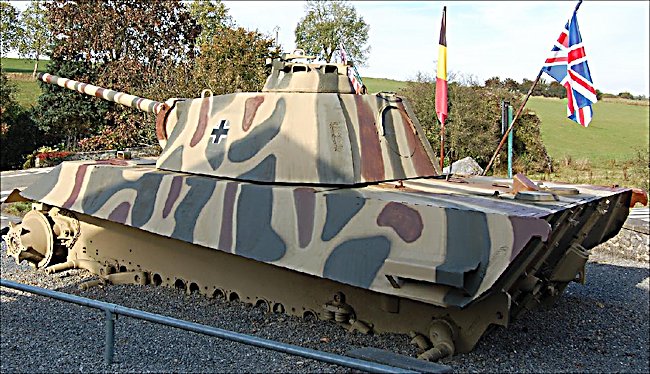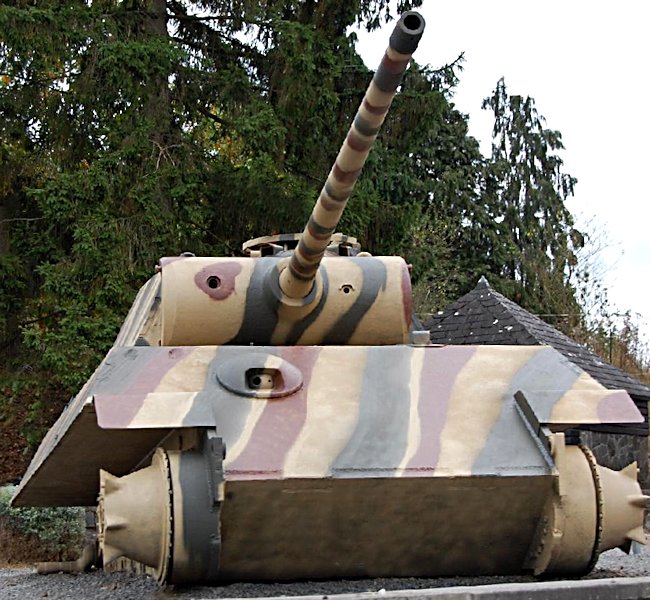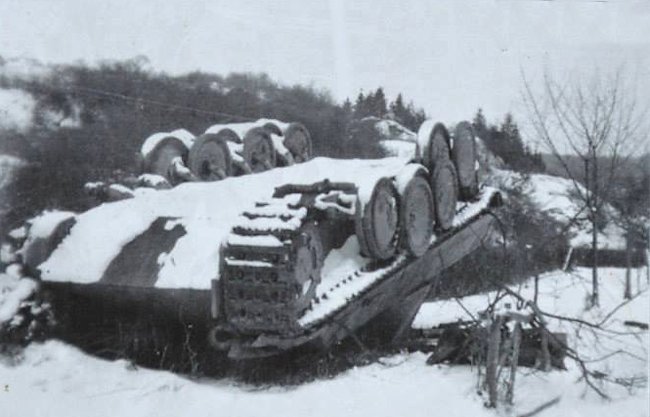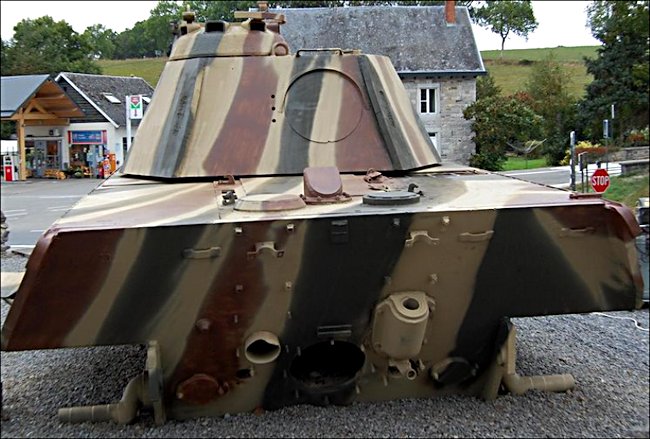Celles Panther Tank Ausf. G
This Surviving German Panzer V Panther Ausf. G tank took part in the 1944 WW2 Battle of the Bulge in the Belgium Ardennes. It has been preserved and can be visited in the small village of Celles, 10km south east from Dinant on the N94 at the cross roads with the N910 .

German Panzer V Ausf. G Panther Tank (Sd.Kfz 171) in the village of Celles
The Celles Panther was part of the German Army Kampfgruppe (combat group) von Cochenhausen, 2nd Panzer Division. On 21st December Panzer Lehr battle group was pulled out of the fight for Bastogne and regrouped with 2nd Panzer Division and the 116th Panzer Division Windhund for an assault on the town of Dinant to secure the crossing over the river Meuse. It fought its way through the town of St Hubert and the road to Dinant seemed open. Rochefort was taken on 23rd December 1944.
On the 24th December 1944 the advanced column of Panther tanks approached the junction of the N510 road with the N48. The local story is that the German's asked at the cafe 'pavillon des Ardennes' if the road to Dinant was open, had vehicles been using it recently. The Marthe Monrique, the cafe owner, lied and said that it was mined and dangerous so the Panzer V commander decided to go through the fields. This Panzer V Ausf. G was the lead tank. It drove over a mine and was put out of action in the field below the Chateau Acteau. The Germans stopped their advance for a while. After the war Marthe Monrique became known as the woman who stopped the tanks.

German Panzer V Panther Tank in the village of Celles
When Panzer Lehr resumed its advance to Dinant it ran into the combat command A of the US 2nd Armored Division near Buissonville. On Christmas Day the protective winter thick cloud cover disappeared and the full force of the Allies air power was deployed, bringing the Panzer Divisions to a virtual standstill. The majority of 2nd Panzer's tanks, under Major Ernst von Cochenhausen had become surrounded near the town of Celles.
On 26th of December the rest of Panzer Lehr made two attempts to relieve them but they were turned back by allied fighter bombers. Cochenhausen and 600 or so of his men managed to escape on foot, having been forced to abandon all of the Division's tanks and equipment to the advancing Allies.
The disabled Panther at Celles was left there for some time after the war. It had flipped over and was resting on its turret by the side of the road to Neufchateau. It was during this period that the hatches, tracks and road wheels were removed as they were easy to get to.

After being blown up by the mine it was left in the field upside down in the village of Celles
The Americans tested anti tank weapons on it. American Army engineers stripped it to try and make it lighter but they could not get it out of the field. The Panther had ejectable hatches, so the crew would eject them and leave them on the ground. The cafe owner Marthe Monrique rescued the tank from the field in 1948 and put in pride of place next to the Cafe now renamed as "Le Tank" at the crossroads, as a monument.
How many tanks did the Germans have during the Battle of the Bulge?
The German army had amassed an impressive lineup of forces for the Ardennes is offensive. The powerful 6th Army was positioned in the North West of Germany commanded by General Sepp Dietrich. It included the 1st, 2nd, 9th and 12th SS Panzer Divisions. Their task was to advanced along a route, from their forming up position near the German town of Dahlem, and into Belgium around the town of Losheim. Their objective was to cross the Meuse River just below the town of Leige and then head towards Antwerp, the allies major supply port.
Just the South of this force was the 5th Army under the command of Lieutenant General Hasso von Manteuffel. It included the 2nd, 9th and 116th Panzer Divisions plus the 15th Panzer Grenadier and Panzer Lehr Divisions. Their objective was to move from their forming up position near the German town of Prum and cross the Meuse River south of Brussels and on to Antwerp.

German Panzer V Panther Tank in the village of Celles
The 7th Army was to take the southernmost route during the Ardennes is offensive fire Luxembourg. It was led by General Erich Bradenburger. This was the infantry only division made up from the fifth division, including some elite paratroop forces. They were to move off from the German town of Bitburg, and into the area held by the US 3rd Army near the French border, south of Bastogne, with the object of tying down his forces to stop interfering with the main spearhead attacks.
All these forces were part of German Army Group B commanded by Field Marshall Walter Model who was best noted for his defensive tactics and not as offensive General. This total force had around 2000 artillery pieces, over 1000 tanks and assault guns, and 250,000 men. To have assembled this impressive force after the violent battles since the Allied landings in Normandy was an impressive feat of logistics. Especially as the buildup remained undetected.
We need fuel and ammo!
During the Battle of the Bulge in December 1944, the Germans were very short of fuel. On Christmas Eve the armoured column of the 47th Panzerkorps had reached the Belgium village of Celles heading towards the River Meuse.
One of the rearguard units belonging to battle group Kampfgruppe von Cochenhausen consisted of three Panther tanks and about 10 half tracks. It passed through the village of Custinne at about 8am. Each Panther tank was towing up to 3 trucks. This is an excellent example of the German Army's critical shortage of fuel and the resourceful way in which the troops tried to overcome this problem.
During the night the Americans had picked up German radio conversation. One German unit asked the other whether it had captured any fuel that day. Enquiries were made about ammunition levels. Because of resupply problems, the forward elements of the advance were unable to participate in the aggressive action that had been planned.
The story of a Panther that lots its 75mm gun
A brand new German Panther tank with a turret number of 225 belonging to 1./SS-Panzer-Regiment I under the command of Kampfgruppe Peiper was knocked out during the Battle of the Bulge at Stoumonton the 19th December 1944. It’s commander was Rottenführer Prahm who was ordered to take the lead point with the remaining Panzers of 2.Zug (platoon) of 1./SS-Pz.Rgt. I, which was followed by Hauptscharführer Knappich in Panther 221 and then Oberscharführer Ropeter in Panther 222.
It was hit initially coming around a bend in the main route to Stoumont (N33) by four 75mm rounds which ricocheted off the Panther’s frontal glacis plates. It then continued on and thus entered the sights of a 90mm AA gun commanded by Sgt.Sarnowski, the gun fired with the first shot hitting in the vicinity of the left front sprocket.
The second shot hit the 75mm barrel close to the gun mantlet, shearing it off. Four more rounds were fired off, with the Panther’s crew bailing out in quick succession. One more round was fired off 'for good measure’ and this proved to the only round that actually penetrated the armor. The Panther’s gunner Sturmmann Hübler never had a chance to fire of the main gun and so, Panther 225 never actually fired a round in anger during its short career. Tank Gunner Sturmmann Hans-Georg Hübler survived, as did his loader Sturmmann Werner Zander.
1.Kompanie and the 2.Kompanie applied their tactical markings on their vehicles in a different way. Panther tanks in both Kompanies had their tank number painted on the side of the turret but 2.Kompanie tanks had their tank's tactical number repeated using a smaller version of the standard LAH tactical numbers on the rear of the turret in the top left corner by the side of the escape hatch. 1. Kompanie did not use this method and the turret numbers were only painted in the usual manner, on the side of the turret. The wreck of Panther 225 had its identity number on the side of the turret and on the rear.
Hotton 19-21 Dec 1944
Gen Krueger, commander of the 58th Panzer Corps on von LÜttwitz's left flank, was a cautious man. For that reason von Manteuffel had given him the understrength 560th Volks Grenadier Division and one armoured division, the 116th Panzer before the attack. At first, Krueger had lived up to von Manteuffel's expectations or lack of them, but suddenly the opposition that the 58th Panzer Corps faced at St Vith seemed to melt away. Krueger; as cautious as he was, couldn't miss the opportunity being offered to him when his neighbours on both flanks were bogged down in heavy fighting.
He slipped his infantry and tanks through the fifteen-mile or so gap between the St Vith 'goose-egg' and the American defensive perimeter forming around Bastogne. Again his luck held out. He had an easy passage until the 'Greyhounds', as the men of the 116th Panzer Division were known, on account of the many lightning thrusts they had made in Russia and elsewhere, struck Samree.
Here both sides were taken by surprise, but the advantage was on the side of the Germans. Samree was defended by a mixed bag of Americans, mainly from the US 7th Armored Division, but the Germans acted first. Suddenly, the grey morning sky was torn apart by the wail of German multiple mortars. Great streaks of smoke shot over no-man's land before the mighty 155 mm rockets slammed into the American positions, making the earth tremble like a live thing.
A few minutes later, six German Panthers started to rattle forwards to the attack. Two American Staghound armoured cars took up the challenge, but they didn't last long. Now it was the turn of the Sherman tanks following the already burning armoured cars, their crews sprawled out about them like bundles of bloody abandoned rags. One by one they were knocked out in rapid succession. They didn't stand a chance against the superior cannon and armour of the Panthers. In some cases the solid, white, armour-piercing shells bounced off the Panthers' steep glacis plates like deadly ping-pong balls. That did it: the surviving tankers fled, leaving Samree in the hands of the victorious Germans.
Again the usual looting commenced, but this time the Germans didn't just find the customary Hershey chocolate bars and Lucky trike cigarettes; they also discovered 25,000 gallons of fuel and 15,000 rations abandoned by the fleeing 'Amis': enough to supply the 'Greyhounds' for days to come.
While the Americans reacted slowly — the US 3rd Armored Division was ordered to counter-attack the following day — Gen Krueger, showed surprising speed and alacrity for such a slow, pedantic commander. He ordered a mixed battle group of tanks, self-propelled guns, armoured cars and mortars to move off smartly westwards. Their objective was the Hotton—Soy road and the bridge across the River Ourthe. The Ourthe had two sources, one of which flowed into the River Meuse, and Krueger knew that it would make an ideal stopline for the Americans to the west of Bastogne. He knew, too, that if he beat them to it, it would be a great victory for the 58th Panzer Corps.
For a while the battle group advanced at a healthy pace, The heavily wooded countryside with steep hills, topped with crowns of snow, on both sides of the road seemed empty of 'Amis'. No one, apparently, was about to stop the panzers, crawling westwards at about ten miles an hour. Slowly the valley in front of the German tank at point started to widen. Here at Hotton the river was broader, with the little village school and the run-down Hotel de la Paix on the north bank and the rest of the village on the other.
The Germans surveyed the place through their glasses. Here, for the first time since they set out on their ride into the unknown, there were signs of 'life. At the sturdy wooden bridge, which replaced the one they had destroyed during their retreat three months before, there were a handful of 'Amis', muffled up in scarves and overcoats, and stamping up and down in the snow as they guarded it.
Outside the Café de la Paix, there were two enemy tanks, obviously under repair. Hotton seemed theirs for the taking. Indeed, the village township was guarded by a mere 120 troops of the US 3rd Armored Division's rear echelon: mostly clerks, medics, signallers and the like. They were billeted in the school and were at that moment eating dried eggs and toast for breakfast, known to them as 'shit on shingle'.
At 0730 hr the usual dreary breakfast was disturbed by the sharp crack and twang of a mortar opening fire. It was followed an -instant later by another. In a flash, the bombs came tumbling out of the grey sky to explode with startling suddenness all around the bridge and school. Five minutes afterwards two Panthers broke cover. They came rambling from the snow-heavy firs on the heights and headed straight for the vital bridge across the River Ourthe.
Sgt Vern Sergent and Pte Hugh Lander took up the challenge with a bazooka. The American anti-tank weapon was inferior to the German Panzerfaust, but at that distance the rocket launcher couldn't fail. The lead Panther was struck in its fuel tank. Petrol started to spill out of the ruptured tank, filling the morning air with the cloying stink of escaping fuel. Close by a lone Sherman rumbled up to fire, too. It got off the first shot. The armour-piercing shell hurried across the intervening space in a frantic white blur, but in vain. The Sherman gunner missed.
The next moment the Panther's long, overhanging 75 mm cannon spat fire. The Sherman reeled back in its bogies like a wild horse being put to the saddle for the first time. Its cannon drooped: it was out of the fight. Then the Americans struck lucky again when another bazooka team put the second Panther out of action. Its shocked crew tumbled out and ran for safety. The drive of the 116th Panzer had come to an abrupt halt.
Where can I find other preserved Panther Tanks?
- Panther Ausf. A - Wheatcroft Collection, England
- Panther Ausf. A - Befehlspanzer Munster Germany (running condition)
- Panther Ausf. A - (n° 224) Auto + Technik Museum, Sinsheim, Germany
- Panther Ausf. A - (n° 243) Auto + Technik Museum, Sinsheim, Germany
- Panther Ausf. A - (n° 413) Private Collection, Germany
- Panther Ausf. A - (n° 256) Saumur Tank Museum France
- Panther Ausf. A - (n° 211) Saumur Tank Museum France (running condition)
- Panther Ausf. A - Omaha Overlord Museum, Colleville-sur-Mer, France
- Panther Ausf. A - 501/503e RCC Mourmelon-le-Grand France
- Panther Ausf. A - (n° 201) Royal Jordanian Tank Museum, Jordan
- Panther Ausf. A - Australian Armour and Artillery Museum, Cairns, Queensland.
- Panther Ausf. A - National Armor and Cavalry Museum, Fort Benning, GA,USA
- Panther Ausf. A - U.S. Army Ordnance Museum, Fort Lee, VA, USA
- Panther Ausf. A - The Collings Foundation, Stow, MA, USA (running condition)
- Panther Ausf. A - Canadian War Museum (CWM) in Ottawa Canada
- Panther Ausf. A or D Panzermuseum, Thun, Switzerland
- Panther Ausf. D - Breda Netherlands
- Panther Ausf. G - Bovington Tank Museum England (British Built)
- Panther Ausf. G - Wehrtechnische Dienststelle, Trier, Germany (British Built)
- Panther Ausf. G - Privately owned now confiscated by police, Germany (British Built)
- Panther Ausf. G - National War and Resistance Museum, Overloon Netherlands
- Panther Ausf. G - Houffalize Belgium
- Panther Ausf. G - Grandmenil Belgium – engine, gearbox and transmission are present
- Panther Ausf. G - Celles Belgium
- Panther Ausf. G - (n° 332) Saumur Tank Museum France
- Panther Ausf. G - Kubinka Tank Museum Russia (running condition)
- Panther Ausf. G - U.S. Army Ordnance Museum, Fort Lee, VA, USA
- Panther Ausf. G - 2x National Armor and Cavalry Museum, Fort Benning, GA, USA
- Source - Pierre-Oliver Buan - http://the.shadock.free.fr/Surviving_Panzers.html
Battle of the Bulge books

